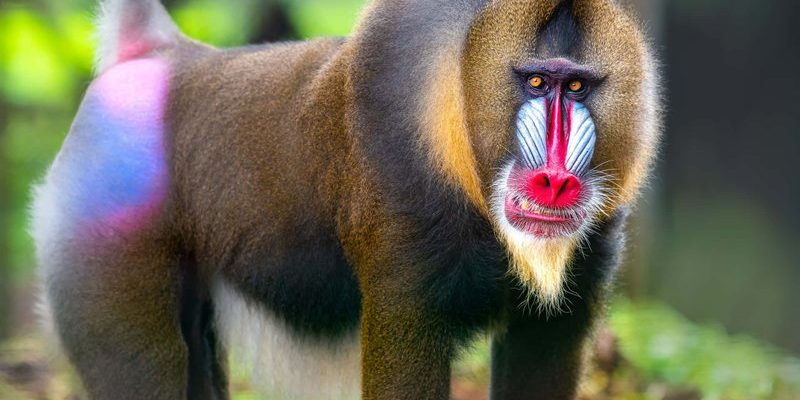![Comparing The Mandrill Vs. [Similar Species]](https://gudri.com/wp-content/uploads/2025/06/Comparing_The_Mandrill_Vs___Similar_Species__image_0.jpg)
Physical Differences Between Mandrills and Baboons
One of the first things you’ll notice when looking at mandrills and baboons is their appearance. Mandrills are true showstoppers. They have bright blue and red facial markings, especially on the males, which give them a unique look that’s almost like living art. Their fur is mostly brown with a vibrant underbelly, and they’re among the largest monkeys in the world.
On the flip side, baboons sport a more subdued palette. While they might not flaunt bold colors, they are still impressive. They come in several species, including the yellow baboon and the olive baboon, and usually have a mix of tan and gray fur. Their faces are more subtle but still expressive, often sporting a more elongated muzzle compared to mandrills.
It’s also worth noting their size. Mandrills can weigh over 100 pounds, making them hefty primates. Baboons can vary significantly in size depending on the species, with some weighing as little as 30 pounds and others reaching up to 90 pounds. This size differentiation impacts their behavior and social structures.
Habitat: Where Do They Live?
Mandrills are primarily found in the rainforests of Central Africa. They prefer dense, tropical forests but can be found in nearby wooded areas. It’s like they’ve chosen the most vibrant stage for their show—plenty of foliage to hide in, yet still lots of room to roam. These habitats provide food sources, including fruits, seeds, and occasionally insects.
Baboons, on the other hand, are more versatile when it comes to their habitats. You’ll find them in savannas, woodlands, and even semi-deserts across Africa. They’re like that friend who can go with the flow, adapting to various environments. This adaptability allows them to thrive in many regions and they often forage for roots, bulbs, and small animals.
Both of these species have adapted well to their specific habitats, but their living environments significantly influence their behavior and social structures.
Social Structures: How Do They Live Together?
When you think about social behavior, mandrills have a rather unique setup. They live in large groups called troops, which can include up to 200 members. Imagine a bustling community where everyone is out for a good time! The males are much more colorful than the females, and during mating seasons, it’s the females who choose their partners based on the males’ vibrant colors and displays.
Baboons also live in troops, but theirs are typically smaller, often around 20–50 individuals. The social dynamics are a bit different; baboon troops are matriarchal, meaning the females usually lead the group. This structure helps maintain order and ensures the survival of the young. You might find that while mandrills lean into flashy courtship, baboons prioritize stability and community bonds.
Both species exhibit fascinating social interactions, but the way they form their communities has a significant impact on their behavior.
Diet: What Do They Eat?
Diet is another crucial aspect that sets mandrills and baboons apart. Mandrills are omnivores, and their diet consists mostly of fruits, seeds, and various small animals. They often forage on the forest floor, using their keen sense of smell to sniff out tasty treats. With their colorful appearance, they seem to embody the vibrant life of the forest.
Baboons, too, are omnivores but have a slightly broader diet. They often eat grass, seeds, fruits, and even hunt small animals. Their ability to adapt to different food sources makes them successful in varied habitats. You might catch a baboon rummaging through a trash can in a national park, showcasing their resourcefulness and intelligence.
Both species contribute to their ecosystems by helping disperse seeds and controlling insect populations, making them vital players in their environments.
Behavior: Playful or Serious?
When it comes to behavior, mandrills can be quite playful. They engage in a variety of social interactions, including grooming and playing. You might see them showcasing their vibrant faces in a playful display to attract attention. Their lively nature makes them fascinating to observe in the wild.
Baboons can also display playful behaviors, but they often appear more serious. They have a reputation for being more aggressive, especially when protecting their young or territory. Yet, don’t let that fool you; they also engage in playful antics within their troops—think of a playful wrestling match among siblings.
In short, although both species exhibit playful behaviors, their overall temperament can differ significantly based on their social structures and environments.
Conservation Status: How Are They Faring?
Both mandrills and baboons face challenges in the wild, but their conservation status varies. Mandrills are considered vulnerable, largely due to habitat loss and hunting pressures. Their striking appearance makes them targets in some areas, leading to a decline in their populations. Conservation efforts focused on habitat preservation and protection are essential for their survival.
Baboons, however, are more adaptable and widespread, which has allowed many species to thrive. Their ability to live near human settlements has helped some populations remain stable. Still, certain baboon species, like the hamadryas baboon, face threats from habitat destruction and hunting.
Keeping an eye on their populations is vital. Supporting conservation initiatives and learning more about these creatures can help ensure their survival for future generations.
Final Thoughts: Appreciating the Differences
Understanding the differences between mandrills and baboons allows us to appreciate the incredible diversity of the animal kingdom. From their colorful appearances to their unique social structures, these primates showcase the beauty of evolution and adaptation.
Next time you find yourself captivated by a documentary or a zoo exhibit featuring these animals, remember their distinct qualities. Whether it’s the flamboyant mandrill or the resourceful baboon, both play important roles in their ecosystems. By nurturing interest and promoting conservation, we can contribute to protecting these fascinating species and the rich biodiversity they represent.

